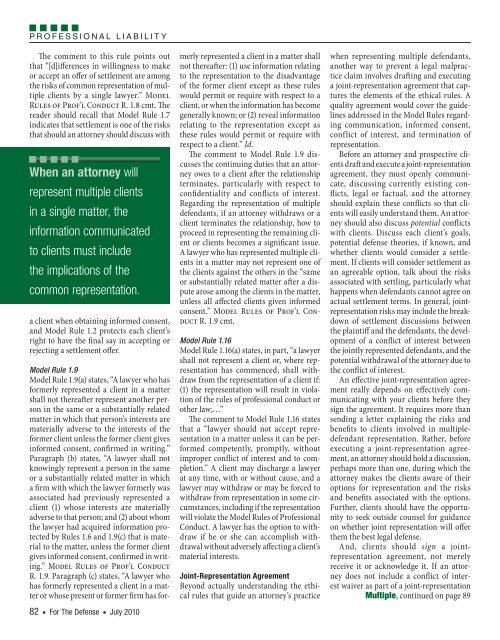For The Defense, July 2010 - DRI Today
For The Defense, July 2010 - DRI Today
For The Defense, July 2010 - DRI Today
- No tags were found...
You also want an ePaper? Increase the reach of your titles
YUMPU automatically turns print PDFs into web optimized ePapers that Google loves.
P R O F E S S I O N A L L I A B I L I T Y<strong>The</strong> comment to this rule points outthat “[d]ifferences in willingness to makeor accept an offer of settlement are amongthe risks of common representation of multipleclients by a single lawyer.” ModelRules of Prof’l Conduct R. 1.8 cmt. <strong>The</strong>reader should recall that Model Rule 1.7indicates that settlement is one of the risksthat should an attorney should discuss withWhen an attorney willrepresent multiple clientsin a single matter, theinformation communicatedto clients must includethe implications of thecommon representation.a client when obtaining informed consent,and Model Rule 1.2 protects each client’sright to have the final say in accepting orrejecting a settlement offer.82 n <strong>For</strong> <strong>The</strong> <strong>Defense</strong> n <strong>July</strong> <strong>2010</strong>Model Rule 1.9Model Rule 1.9(a) states, “A lawyer who hasformerly represented a client in a mattershall not thereafter represent another personin the same or a substantially relatedmatter in which that person’s interests arematerially adverse to the interests of theformer client unless the former client givesinformed consent, confirmed in writing.”Paragraph (b) states, “A lawyer shall notknowingly represent a person in the sameor a substantially related matter in whicha firm with which the lawyer formerly wasassociated had previously represented aclient (1) whose interests are materiallyadverse to that person; and (2) about whomthe lawyer had acquired information protectedby Rules 1.6 and 1.9(c) that is materialto the matter, unless the former clientgives informed consent, confirmed in writing.”Model Rules of Prof’l ConductR. 1.9. Paragraph (c) states, “A lawyer whohas formerly represented a client in a matteror whose present or former firm has formerlyrepresented a client in a matter shallnot thereafter: (1) use information relatingto the representation to the disadvantageof the former client except as these ruleswould permit or require with respect to aclient, or when the information has becomegenerally known; or (2) reveal informationrelating to the representation except asthese rules would permit or require withrespect to a client.” Id.<strong>The</strong> comment to Model Rule 1.9 discussesthe continuing duties that an attorneyowes to a client after the relationshipterminates, particularly with respect toconfidentiality and conflicts of interest.Regarding the representation of multipledefendants, if an attorney withdraws or aclient terminates the relationship, how toproceed in representing the remaining clientor clients becomes a significant issue.A lawyer who has represented multiple clientsin a matter may not represent one ofthe clients against the others in the “sameor substantially related matter after a disputearose among the clients in the matter,unless all affected clients given informedconsent.” Model Rules of Prof’l ConductR. 1.9 cmt.Model Rule 1.16Model Rule 1.16(a) states, in part, “a lawyershall not represent a client or, where representationhas commenced, shall withdrawfrom the representation of a client if:(1) the representation will result in violationof the rules of professional conduct orother law;…”<strong>The</strong> comment to Model Rule 1.16 statesthat a “lawyer should not accept representationin a matter unless it can be performedcompetently, promptly, withoutimproper conflict of interest and to completion.”A client may discharge a lawyerat any time, with or without cause, and alawyer may withdraw or may be forced towithdraw from representation in some circumstances,including if the representationwill violate the Model Rules of ProfessionalConduct. A lawyer has the option to withdrawif he or she can accomplish withdrawalwithout adversely affecting a client’smaterial interests.Joint-Representation AgreementBeyond actually understanding the ethicalrules that guide an attorney’s practicewhen representing multiple defendants,another way to prevent a legal malpracticeclaim involves drafting and executinga joint- representation agreement that capturesthe elements of the ethical rules. Aquality agreement would cover the guidelinesaddressed in the Model Rules regardingcommunication, informed consent,conflict of interest, and termination ofrepresentation.Before an attorney and prospective clientsdraft and execute a joint- representationagreement, they must openly communicate,discussing currently existing conflicts,legal or factual, and the attorneyshould explain these conflicts so that clientswill easily understand them. An attorneyshould also discuss potential conflictswith clients. Discuss each client’s goals,potential defense theories, if known, andwhether clients would consider a settlement.If clients will consider settlement asan agreeable option, talk about the risksassociated with settling, particularly whathappens when defendants cannot agree onactual settlement terms. In general, jointrepresentationrisks may include the breakdownof settlement discussions betweenthe plaintiff and the defendants, the developmentof a conflict of interest betweenthe jointly represented defendants, and thepotential withdrawal of the attorney due tothe conflict of interest.An effective joint- representation agreementreally depends on effectively communicatingwith your clients before theysign the agreement. It requires more thansending a letter explaining the risks andbenefits to clients involved in multipledefendantrepresentation. Rather, beforeexecuting a joint- representation agreement,an attorney should hold a discussion,perhaps more than one, during which theattorney makes the clients aware of theiroptions for representation and the risksand benefits associated with the options.Further, clients should have the opportunityto seek outside counsel for guidanceon whether joint representation will offerthem the best legal defense.And, clients should sign a jointrepresentationagreement, not merelyreceive it or acknowledge it. If an attorneydoes not include a conflict of interestwaiver as part of a joint- representationMultiple, continued on page 89
















